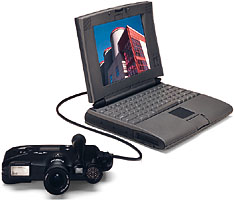| Annual Report 1996 | ||
| Annual Report 1996 | ||
Polaroid commercial imaging provides complete imaging solutions, using both instant photographic and digital technology. These solutions serve a variety of commercial markets, including identification, photo retailing, document photography, insurance and real estate, and professional and technical imaging.
New digital solutions and aggressive entry into developing markets were the keystones of growth for commercial imaging during the year. The developing markets of Asia Pacific, especially China and South Korea, played a critical role in this growth strategy. In 1996, commercial imaging introduced more than 30 market-focused products, ranging from an entirely new film architecture to digital products and systems targeting virtually every market and geographic region.
Chris De Bleser is vice president and general manager, professional and technical markets, commercial imaging group. He joined Polaroid in 1996 from Black & Decker Corporation, where he was vice president and general manager for outdoor products, North America. De Bleser has a B.S. degree in finance from RUCA, Antwerp, Belgium and a postgraduate degree in marketing management from UFSIA, Antwerp. A new film platform
Polacolor 679 (ISO 100, 3 1/4x4 1/4 inch format), Polacolor 579 (ISO 100, 4x5 inch format) and Studio Polaroid (ISO 125, 3 1/4x4 1/4 inch format) instant peel-apart films are the culmination of a major Polaroid development program. Based on a sixth-generation film platform, they represent a major advance in instant image quality.
Each film is customized for a specific market: professional photographers and Studio Polaroid and Studio Express document photographers. Noted for highly accurate color and faster drying time, the new peel-apart films were enthusiastically received at the Photokina'96 exhibition in Cologne, Germany, and will be introduced in the United States in 1997.
The faster drying time and brilliant colors of new Polacolor 679 and 579 films were developed to suit the needs of professional and document photographers. Secure identification systems
Polaroid's secure identification business serves corporations, government agencies and other institutions. Polaroid integrates and operates digital, photographic and "hybrid" identification systems for high-volume production of durable, tamper-resistant, reasonably priced identification cards.
New, more versatile digital systems are fostering steady growth in the secure identification business with such features as machine-readable barcodes, encoded magnetic strips and holograms for added security.
In 1996, the governments of Brazil and Honduras selected Polaroid systems to supply alien identification cards and national identification cards respectively. Indonesia selected Polaroid to provide patent and trademark certificate protection, and the company provided auto registrations in several provinces of China.
In addition, Polaroid installed major new driver's license systems in Georgia, Tennessee, Oregon and Iowa as well as in Russia, and added to a major contract with the government of Mexico.Polaroid also developed a marketing agreement with First Data Corp. to supply bank card issuers with secure, personalized cards bearing the holder's photo and signature. Polaroid provides image-capture capability at bank branches and assists with marketing programs, installation and support to retail bank networks. First Data converts photographic images into digital form and manages card production. Photo retailing
Polaroid's photo retailing business encompasses markets and applications in which retailers create and sell images to an end-user. Included are document photography for passports or visas, street photography, event/entertainment photography, copies and enlargements.
Polaroid continues to enjoy worldwide name recognition, excellent relationships and strong market share in the photo retailing business, particularly in developing markets around the world.
Street photographers and tourists enjoy the benefits of instant photography for souvenir photographs at the Forbidden City, Beijing, China.
New products for photo retailing in 1996 included two digital workstations: Polaroid Make-A-Memory for the entertainment market, incorporating Polaroid's new PDC-2000 digital camera, introduced in the United States in the fourth quarter; and Make-A-Print, which prints copies and enlargements, introduced in Australia in 1996 and slated for U.S. and European introductions in 1997.
A new model of the Polaroid Photobooth, introduced in Australia and the United States in 1996, uses a multi-lens camera to deliver four different poses on a single sheet. This variation on a familiar format provides added value for consumers at movie theaters, shopping malls, amusement parks and special events.Professional and technical imaging
Polaroid's professional and technical business includes vertical markets in which imaging is used to accomplish a job or evaluate a work process. Pre-eminent markets include law enforcement, professional photography, manufacturing, and scientific, medical and technical imaging.
In 1996, Polaroid Domestic Violence Kits won broad acceptance among law enforcement officials who must document evidence of domestic abuse. Public safety organizations in Miami, Los Angeles, San Diego, New York and Boston joined the growing roster of users. Medical professionals and organizations, such as the Health Foundation of South Florida, made use of similar kits, designed for medical applications. Polaroid supplied free training to major users of these kits.
The Polaroid Macro 5 SLR instant close-up camera, introduced in late 1995, was extremely well-received by dentists, ophthalmologists, optometrists, dermatologists, forensic specialists, scientific researchers and other professionals who need to document their work. The Macro 5 camera greatly simplifies close-up photography by providing high-quality, self-developing instant color prints at five magnifications, from one-fifth to three times life size.Business imaging
Business imaging at Polaroid provides photographic and digital solutions to many small, decentralized business markets and several large ones, including insurance, real estate, construction and auto body repair. Collectively, these markets account for a considerable portion of integral film sales in the United States and Japan.
A major milestone in 1996 was Polaroid's five-year marketing agreement with HFS, Inc., owner of Century 21, Coldwell Banker and ERA real estate franchises in the United States. Polaroid will market its broad array of instant and digital cameras, film, scanners and LCD panels and projectors directly to HFS franchises, providing special services and imaging solutions designed specifically for real estate professionals.Sponsored by Polaroid, a well-known real estate industry spokesperson will author a regular column in leading trade publications on how to use imaging technology effectively. Polaroid's exclusive Web sites - one for each HFS franchise - will provide current and prospective users with extensive product and application information.

Business imaging users document construction site progress and find that photographs of house details can help sell homes to potential buyers.
The Polaroid Digital Imaging Kit, introduced in 1996, offers consumers and small-business users a convenient option for converting instant images to digital format, storing them electronically and distributing them over the World Wide Web. The kit, including an instant camera, a Polaroid PhotoPad scanner (available in both Macintosh and PC versions), software and instant film, is one of the first Polaroid solutions to be sold through office superstores.
The 10th anniversary of the Polaroid Education Program included a series of Back-to-School Days for 1,600 U.S. educators in eight major cities. Stressing creative ways to promote visual learning, the program has reached more than 500,000 teachers nationwide.Digital imaging products
In 1996, the digital imaging product group focused closely on image-capture solutions to meet the needs of its primary customers: global corporate accounts that use digital images to reinforce their communications, sales and marketing efforts; and computer-savvy, image-oriented home office users. Among the many new digital imaging products from Polaroid, the PDC-2000 Digital Camera debuted to unanimous acclaim in 1996. Polaroid's first digital camera uses a new, "megapixel" imaging sensor to deliver extremely high-quality digital images so that users truly "see the picture, not the pixels." These images are easily transferable to any computer with no loss of data or sacrifice of image quality.
The PDC-2000 camera provides high-resolution digital images at far lower cost than alternative products. It meets the needs of Web site developers, desktop publishers, ad agencies, fashion photographers, graphic designers, business imagers and many others. Recognized as Best Digital Product of 1996 by the European Technical Image Press Association, the PDC-2000 appeared on the covers of seven major trade and computer publications. The PDC-2000 also received Publish magazine's 1996 Impact Award as one of the products expected to have the greatest impact on the way Publish readers work. Netguide Magazine gave the PDC-2000 its State-of-the-Art Award.
Several new models broadened the range of Polaroid's line of 35mm film scanners, which let professionals in a variety of markets convert transparencies to digital form for use as final art. New in 1996 were SprintScan 45, which scans transparencies ranging in size from 35mm to 4x5 inches for desktop publishing, graphic arts departments and pre-press service bureaus; SprintScan 35LE, a lower-priced option for developing Web sites, multimedia presentations and desktop publishing documents; and SprintScan 35 Plus, ideal for design and publishing applications requiring very high shadow detail and brilliant colors.
New software and accessories, introduced in 1996, greatly expanded the potential base of users for the Polaroid ProPalette 8000 digital film recorder, which instantly converts digital images into professional-quality 35mm slides, prints or chromes, working from the electronic desktop. Polaroid announced new ProPalette software upgrades for both the Macintosh and Windows 95 environments as well as three ProPalette accessories: a 4x5 inch large-format camera, a 6x7 inch medium-format camera and a 6x8 inch medium-format camera.
Digital presentation products introduced in mid-1996 include the Polaview 110 LCD projector and Polaview 1900 and 1700 LCD panels, all designed to help business presenters deliver high-impact presentations in a variety of settings.
In September, two additional projectors joined the presentation products family. The Polaview 220 DLP projector features advanced digital light processing technology from Texas Instruments and SVGA (Super Video Graphics Array) resolution to support superior image quality and full-motion video. The Polaview 305 LCD projector delivers high-resolution imaging for presentation of complex analytical or diagnostic images.
During the year-end holiday season, Polaroid announced a free Global Digital Greeting Card, allowing Polaroid Web site visitors to post a personalized photograph and message on the Internet. This promotion, designed to broaden awareness of Polaroid's digital imaging expertise, was the first to let individuals post personal photos and greetings with a free URL address of their own.
